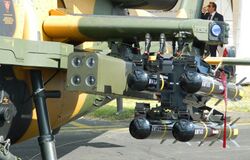Engineering:UMTAS
| UMTAS Long Range Anti-Tank Missile System | |
|---|---|
 L-UMTAS (upper) and UMTAS (lower) missiles displayed on helicopter pylon | |
| Type | Air-to-surface, Anti-tank missile |
| Place of origin | Turkey |
| Production history | |
| Manufacturer | Roketsan A.Ş. |
| Specifications | |
| Mass | 37.5 kg[1] |
| Length | 175 cm |
| Diameter | 16 cm |
| Warhead | Insensitive Anti-armor Tandem Warhead |
| Engine | Solid-fuel rocket |
Operational range | 500–8,000 m |
Guidance system | Two-way RF Data-link Imaging Infrared Seeker (UMTAS) or semi active Laser guidance (L-UMTAS) |
Launch platform | Rotary wing platforms Unmanned combat air vehicle Land combat vehicle Naval platforms |
| Launch and Warhead test | |
UMTAS or Mizrak-U (Uzun Menzilli Tanksavar Sistemi) is a modern long range air-to-surface anti-tank missile developed by Turkish armor and missile manufacturer ROKETSAN.[2][3][4][5][6]
Background
The UMTAS program was initiated in late 2003 by Turkey's Undersecretariat for Defence Industries (SSM), specifically to provide T-129 ATAK combat helicopters with an indigenous guided missile.[7] The UMTAS has been designed to engage tanks and heavily armoured vehicles.[8] It can be integrated to various platforms (Helicopters, UAVs, Land Vehicles, Stationary Platforms, Light Assault Aircraft, Naval Platforms).[3]
Description
The UMTAS missile features "fire and forget" and "fire and update" infrared guidance with a tandem anti-armor warhead.[2] The laser guided version is marketed as the L-UMTAS.[3] It is capable of engaging targets at 8 kilometers.
- Fire Behind Mask
- Can be used in day or night and in adverse weather conditions
- Tandem warhead, effective against reactive armors
- Insensitive munition characteristics against liquid fuel fire and bullet hits
- Communication of seeker image to the user and command by user using Data Link.
- Lock-on before launch or Lock-on after launch (L-UMTAS)
- Update of aim point on the target (UMTAS)
- Switching targets during flight (UMTAS)
- Direct-attack / Top-attacks (UMTAS)
- Fire-and-Forget, Fire-and-Update modes (UMTAS)
Development
Phase 1 (design) was launched in 2005 and completed in 2008.[1]
Phase 2 (development and qualification) was launched in 2008 and completed in 2015.[8]
The L-UMTAS and UMTAS version have been successfully integrated and fired from the Turkish T-129 ATAK helicopter against land targets and from SH-60 Sea Hawks against sea targets.
The missile has also been successfully tested fired from the Bayraktar TB2 UCAV. The missile was dropped from an altitude of 16,000 ft. to hit a 2×2 meter laser-designated target self designated from the drone, at a distance of 8,000 meters.[9]
Serial production has begun with the delivery dates set in 2016.[8]
References
- ↑ Jump up to: 1.0 1.1 1.2 LONG RANGE ANTITANK MISSILE (LRAT) , Roketsan, Retrieved October 11, 2010
- ↑ Jump up to: 2.0 2.1 2.2 "UMTAS LONG RANGE ANTI-TANK MISSILE SYSTEM « Roketsan". https://www.roketsan.com.tr/en/product/umtas-long-range-anti-tank-missile-system/.
- ↑ Jump up to: 3.0 3.1 3.2 3.3 "Long Range Anti-Tank Missile UMTAS « Roketsan". https://www.roketsan.com.tr/en/product/l-umtas-laser-guided-long-range-anti-tank-missile-system/.
- ↑ "UMTAS Long Range Anti-Tank Missile System - Army Technology". https://www.army-technology.com/projects/umtas-long-range-anti-tank-missile-system/.
- ↑ UMTAS (Long Range Anti Tank System) (Turkey) , Jane's Information Group, Retrieved October 10, 2010
- ↑ "Archived copy". http://www.roketsan.com.tr/en/urunler-hizmetler/hassas-gudumlu-fuzeler/umtas-uzun-menzilli-anti-tank-fuzesi/.
- ↑ "SAVUNMA SANAYİİ MÜSTEŞARLIĞI Faaliyet Raporu 2013" (pdf). 2013. p. 99. http://www.sp.gov.tr/upload/xSPRapor/files/d9xWi+ssm2013-yili-faaliyet-raporu.pdf#page=99.
- ↑ Jump up to: 8.0 8.1 8.2 "Roketsan Shows Broad Capabilities". http://aviationweek.com/singapore-airshow-2016/roketsan-shows-broad-capabilities.
- ↑ Eshel, Tamir. "Turkish UMTAS Missile Dropped From a Bayraktar Tactical Drone | Defense Update". http://defense-update.com/20151219_umtas_bayraktar.html.


